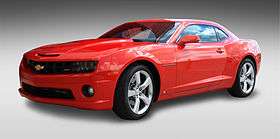Chevrolet Camaro (first generation)
| Chevrolet Camaro (first generation) | |
|---|---|
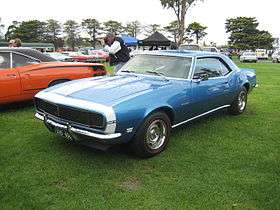 1968 Camaro RS 327 | |
| Overview | |
| Manufacturer | Chevrolet (General Motors) |
| Production | 1966–1969 |
| Model years | 1967–1969 |
| Assembly | |
| Body and chassis | |
| Class | |
| Body style |
|
| Layout | FR layout |
| Platform | F-body |
| Related | Pontiac Firebird |
| Powertrain | |
| Engine | |
| Transmission | |
| Dimensions | |
| Wheelbase | 108 in (2,743 mm) |
| Length |
184.7 in (4,691 mm) (MY1967) [2] 184.7 in (4,691 mm) (MY1968) [3] 186.0 in (4,724 mm) (MY1969) [4] |
| Width |
|
| Height |
|
| Chronology | |
| Successor | Chevrolet Camaro (second generation) |
The first-generation Chevrolet Camaro appeared in Chevrolet dealerships in September 1966,[5] for the 1967 model year on a brand-new rear-wheel drive GM F-body platform and was available as a 2-door, 2+2 seat, hardtop (no "B" or center pillar) or convertible with a choice of six-cylinder and V8 power plants.[6] The first-generation Camaro was built through the 1969 model year.
The Camaro's standard drive train was either a 230 cu in (3.8 L) straight-6 engine rated at 140 hp (104 kW) or a 327 cu in (5.4 L) (307 cu in (5.0 L) later in 1969) V8 engine, with a standard three-speed manual transmission. There were 8 (in 1967), 10 (in 1968), and 12 (in 1969) different engines available in 1967-1969 Camaros. The two-speed "Powerglide" automatic transmission was optional. The three-speed "Turbo Hydra-Matic 350" automatic became available starting in 1969. The larger Turbo 400 three-speed automatic was an option on SS396 cars. A four-speed manual was optional.
There was a plethora of other options available all three years, including three main packages:
The RS was an appearance package that included hidden headlights, revised taillights with back-up lights under the rear bumper, RS badging, and exterior bright trim. It was available on any model.
The SS performance package consisted of a 350 or 396 cu in V8 engine and chassis upgrades for better handling and to deal with the additional power. The SS featured non-functional air inlets on the hood, special striping, and SS badging.
The Z/28 performance package was designed (with further modifications) to compete in the SCCA Trans-Am series. It included a solid-lifter 302 V8, 4-speed transmission, power disc brakes, and two wide stripes down the hood and trunk lid.
The idea of offering such a wide variety of "packages" and numerous options was to "blanket" Camaro's end of the personal car market with everything from a nice, plain and docile Six to a gaudy and fire breathing V8.[6]
Almost all of 1967-1969 Camaros were built in the two U.S. assembly plants: Norwood, Ohio and Van Nuys, California. There were also five non-U.S. Camaro assembly plants in countries that required local assembly and content. These plants were located in the Philippines, Belgium, Switzerland, Venezuela, and Peru.[7]
1967
The 1967 Camaro shared the subframe / semi-unibody design with the 1968 Chevy II Nova. Almost 80 factory and 40 dealer options, including three main packages, were available.
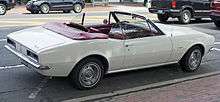
The RS was an appearance package that included hidden headlights, revised taillights with back-up lights under the rear bumper, RS badging, and exterior rocker trim.
The SS included a 350 cu in (5.7 L) V8 engine and the L35 and L78 396 cu in (6.5 L) big-block V8s were also available. The SS featured non-functional air inlets on the hood, special striping, and SS badging on the grille, front fenders, gas cap, and horn button. It was possible to order both the SS and RS to receive a Camaro RS/SS. In 1967, a Camaro RS/SS convertible with a 396 engine paced the Indianapolis 500.
The Z/28 option code was introduced in December 1966 for the 1967 model year. It was the brainchild of Vince Piggins, who conceived offering "virtually race-ready" Camaros for sale from any Chevrolet dealer.[8] This option package was not mentioned in any sales literature, so it was unknown to most buyers.[9] The Z/28 option required power front disc brakes and a close-ratio Muncie 4-speed manual transmission (posi-traction was optional). It featured a 302 cu in (4.9 L) small-block V-8 engine, 3" crankshaft with 4" bore, an aluminum intake manifold, and a 4-barrel vacuum secondary Holley carburetor of 780 cfm. The engine was designed specifically to race in the Trans Am series (which required engines smaller than 305 cu in (5.0 L). Advertised power of this engine was listed at 290 hp (216 kW). This is an under-rated figure.[9] Chevrolet wanted to keep the horsepower rating at less than 1 hp per cubic inch, for various reasons (e.g. insurance and racing classes). The factory rating of 290 hp occurred at 5300 rpm, while actual peak for the high-revving 302 was closer to 360 hp (268 kW) (with the single four barrel carb) and 400 hp (298 kW) (with optional dual-four barrel carbs) at 6800-7000 rpm. The Z/28 also came with upgraded suspension, racing stripes on the hood and trunk lid, '302' front fender emblems on the 67 and early 68 cars, and 'Z/28' emblems in late 68 & 69. It was also possible to combine the Z/28 package with the RS package.
Only 602 Z/28s were sold in 1967, along with approximately 100 Indianapolis Pace Car replicas.[10] The 1967 and 1968 Z/28s did not have the cowl induction hood, optional on the 1969 Z/28s. The 1967 Z28 received air from an open element air cleaner or from an optional cowl plenum duct attached to the side of the air cleaner that ran to the firewall and got air from the cowl vents. 15-inch rally wheels were included with Z/28s while all other 1967-9 Camaros had 14-inch wheels.
The origin of the Z/28 nameplate came from the RPO codes - RPO Z28 was the code for the Special Performance Package. RPO Z27 was for the Super Sport package.
Cars assembled in Switzerland, at GM's local facility in Biel, were all coupes with the 198 PS (146 kW; 195 hp) 4,638 cc (283 cu in) small-block V8 - an engine which was not available in contemporary Camaros built in the United States. The Swiss-built Camaros were not available with the three-speed manual and had a differential lock and front disc brakes as standard. Some additional safety equipment was also standard.[1]
Production numbers:
| RS: | 64,842 |
| SS: | 34,411 |
| Z28: | 602 |
| Total: | 99,855 |
- 1967 Chevrolet Camaro Sport Coupe
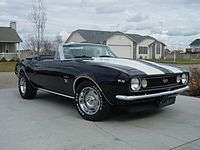 1967 Chevrolet Camaro SS convertible (with Z28 stripes added)
1967 Chevrolet Camaro SS convertible (with Z28 stripes added)
1968
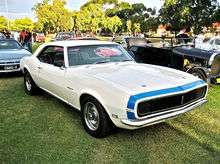

The styling of the 1968 Camaro was very similar to the 1967 design. With the introduction of Astro Ventilation, a fresh-air-inlet system, the side vent windows were deleted. Side marker lights were added on the front and rear fenders which was a government requirement for all 1968 vehicles. It also had a more pointed front grille and divided rear taillights. The front running lights (on non-RS models) were also changed from circular to oval. The big block SS models received chrome hood inserts that imitated velocity stacks.
The shock absorber mounting was staggered to resolve wheel hop issues and higher performance models received multi-leaf rear springs instead of single-leaf units. A 396 cu in (6.5 L) 350 hp (261 kW) big block engine was added as an option for the SS, and the Z28 appeared in Camaro brochures. The 427 cu in (7.0 l) was not available as a Regular Production Option (RPO). Several dealers, such as Baldwin-Motion, Dana, and Yenko, offered the 427 as a dealer-installed replacement for the factory-supplied 396 cid-inch.
1968 was the first year the Z/28 was available for sale to the public. The only reason it was put into production was because of a cleverly hatched plane Chevrolet's Special Production Division came up with to get the Camaro, which was only used for racing at the time, to become a streetable muscle car that could be sold at dealerships. This is important because, let's face it, the Z/28 is without a doubt the most popular Camaro of all the Camaro models. The plan was to build General Manager Elliot "Pete" Estes a Z/28 that he could drive and be impressed by, in turn, helping him get on-board and approve the plan to put into to production the Camaro Z/28 that would ultimately become Camaros legacy. The only problem was he only drove convertible vehicles, so the team put together the rarest Camaro to date: The COPO 1968 Camaro Z/28 Convertible . This (1 of 1) Camaro was the first and only COPO Camaro Z/28 convertible to ever be built.
Production numbers:
| RS: | 40,977 |
| SS: | 27,884 |
| Z28: | 7,199 |
| Total: | 76,060|[11] |
1969

The 1969 Camaro carried over the previous year's drivetrain and major mechanical components, but all-new sheetmetal, except the hood and trunk lid, gave the car a substantially sportier look. The grille was redesigned with a heavy "V" cant and deeply inset headlights. New door skins, rear quarter panels, and rear valance panel also gave the car a much lower, wider, more aggressive look. This styling would serve for the 1969 model year only. Collectors often debate the merits of smooth, rounded lines of 1967 and 1968 model versus the heavily creased and sportier looks of the 1969.
To increase competitiveness in the SCCA Trans-Am racing series, optional four wheel disc brakes with four-piston calipers were made available during the year, under RPO JL8, for US$500.30.[12] This system used components from the Corvette and made for a major improvement in the braking capability and was a key to winning the Trans-Am championship. The option was expensive and only 206 units were produced.
The Rally Sport (RS) option, RPO Z22, includes special black painted grille with concealed headlights and headlight washers, fender striping (except when sport striping or Z28 Special Performance Package is specified), simulated rear fender louvers, front and rear wheel opening moldings, black body sill, RS emblems on grille, steering wheel and rear panel, Rally Sport front fender nameplates, bright accented taillights, back-up lights below rear bumper; also includes bright roof drip moldings on Sport Coupe. $131.65, 37,773 built. This option could be added to any other option (i.e., SS or Z/28), making the model an RS/SS or a RS/Z28.
The Z28 option was still available with the 302 cid small block. It was backed by Muncie four-speed with a new-for-69 standard Hurst shifter and connected to a 12-bolt rear axle with standard 3.73 gears. The 302 featured 11:1 compression, forged pistons, forged steel crankshaft and connecting rods, solid lifter camshaft, and Holley carburetion on a dual-plane intake manifold. A dual four-barrel crossram intake manifold was available as a dealer-installed option.[12]
The 1969 model year was exceptionally long, extending into November 1969, due to manufacturing problem that delayed the introduction of the second generation model planned for 1970. It is a popular myth late-'69 Camaros were sold as 1970 models (due to GM publicity pictures of the '69 Camaro labeled as a 1970), but they were all assigned 1969 VIN codes.
Production numbers:
| RS: | 37,773 |
| SS: | 34,932 |
| Z28: | 20,302 |
| Total: | 93,007 |
COPO 427s
A GM corporate edict forbade Chevrolet from installing engines larger than 400 cu in (6.6 l). Requests from dealers (notably Don Yenko) who were dealer-installing 427 cu in (7.0 l) engines in the Camaro caused Chevrolet to use an ordering process usually used on fleet and special orders (taxis, trucks, etc.) to offer 427 engines in the Camaro. Two Central Office Production Orders (COPO), numbers 9560 and 9561, were offered in the 1969 model year.[13]
The COPO 9561 used the solid-lifter L72 big-block engine, making an underrated 425 hp (317 kW) gross. Yenko ordered 201 of these cars to create the now-legendary Yenko Camaro. Other dealers also became aware of the L72 engine package and ordered it. Around 900-1,000 Camaros were fitted with the L72 engine option.[14]
The COPO 9560 used an all-aluminum 427 cu in (7.0 L) big-block called the ZL-1 and was designed specifically for drag racing. The package was conceived by drag racer Dick Harrell, and ordered through Fred Gibb Chevrolet in La Harpe, IL, with the intention of entering NHRA Super Stock drag racing. A total of 69 ZL-1 Camaros were produced. The engine alone cost over US$4,000—more than the cost of a base V8 hardtop. Though rated at 430 hp (321 kW) gross, the ZL-1 made 376 SAE Net HP in its "as installed" state. With exhaust changes and some tuning, the horsepower jumped to over 500.[13]
The ZL1 engines were hand assembled in a process that took 16 hours each, in a room that Corvette Chief Engineer Zora Arkus-Duntov described as "surgically clean."[15] All ZL1 engines were manufactured at the Tonawanda Assembly Plant before being installed in Corvettes and Camaros, or sold over the counter to racers.[16]
Two of the 69 ZL-1's are known to have landed in Australia, with both owned by local motor racing legend and multi-millionaire tyre retailer Bob Jane, with both cars painted in Jane's team colour Sebring Orange. One of the Camaros was used by Jane for drag racing in Australia (Jane also owned the Calder Park Raceway with the main straight doubling as one of the country's premier drag racing strips). Jane drove the other Camaro to win the 1971 and 1972 Australian Touring Car Championships (the forerunner to today's V8 Supercars), though due to regulation changes restricting engines to a maximum cubic capacity of 6000 cc, Jane was forced to replace the 427 engine with a 350 in 1972. The ATCC winner, which holds the record for the largest capacity car to ever win the championship since it began in 1960. As of 2016, Jane owns his ATCC winning ZL-1, which after its touring car life was sold and used as a Sports Sedan and a drag racer before Jane bought it back and had the car restored to its 1971 specification. Despite his advancing years (approximately 86-87), Jane and the car continue to regularly appear at major historic meetings including the annual Australian Muscle Car Masters held each Fathers Day at the Sydney Motorsport Park.[17]
First-generation engines
- 1967–1969 L26 230 cu in (3.8 L) I6 140 hp (104 kW)
- 1967–1969 L22 250 cu in (4.1 L) I6 155 hp (116 kW) at 4200 rpm, 235 lb·ft (319 N·m) at 1600 rpm
- 1967–1969 Z28 302 cu in (4.9 L) V8 290 hp (216 kW) (rated) 350 hp (261 kW) actual
- 1967–1969 LF7 327 cu in (5.4 L) V8 210 hp (157 kW)
- 1967–1968: L30 327 cu in (5.4 L) V8 275 hp (205 kW)
- 1969: L14 307 cu in (5.0 L) V8 200 hp (168 kW)
- 1969: LM1 & L65 350 cu in (5.7 L) V8 255 hp (190 kW) and 250 hp (186 kW)
- 1967–1969 L48 SS350 350 cu in (5.7 L) V8 295 hp (220 kW) (1969 300 hp (224 kW)) at 4800 rpm, 380 lb·ft (515 N·m) at 3200 rpm
- 1967–1969 L35 SS396 396 cu in (6.5 L) V8 325 hp (242 kW) at 4800 rpm, 410 lb·ft (556 N·m) at 3200 rpm
- 1968–1969 L34 SS396 396 cu in (6.5 L) V8 350 hp (261 kW) at 5200 rpm, 415 lb·ft (563 N·m) at 3200 rpm
- 1967–1969 L78 SS396 396 cu in (6.5 L) V8 375 hp (280 kW) at 5600 rpm, 415 lb·ft (563 N·m) at 3600 rpm
- 1968–1969 L89 aluminum cylinder head option for the L78 SS396/375 engine—lightened the engine by ~100 lb (45 kg).
- 1969 COPO 9561/L72 427 cu in (7.0 L) V8 425 hp (317 kW) at 5600 rpm, 460 lb·ft (624 N·m) at 4000 rpm
- 1969 COPO 9560/ZL1 427 cu in (7.0 L) V8 430 hp (321 kW) at 5200 rpm, 450 lb·ft (610 N·m) at 4400 rpm
References
- 1 2 Braunschweig, Robert, ed. (March 9, 1967). "Automobil Revue Modelle 1967/Revue Automobile modèles 1967" (in German and French). 62. Berne, Switzerland: Hallwag: 222.
- ↑ "1967 Chevrolet Camaro - information kit" (PDF). GM Heritage Center. September 1966. Retrieved March 13, 2016.
- ↑ "1968 Chevrolet Camaro - information kit" (PDF). GM Heritage Center. Retrieved March 13, 2016.
- ↑ "1969 Chevrolet Camaro - information kit" (PDF). GM Heritage Center. September 1968. Retrieved March 13, 2016.
- ↑ Strohl, Daniel (July 6, 2011). "Down the throat: the introduction of the 1967 Camaro". Hemmings Daily. Retrieved March 13, 2016.
- 1 2 Kilpatrick, Bill (October 1966). "The really new ones". Popular Mechanics. 126 (4): 105–108. Retrieved March 13, 2016.
- ↑ Sonen, Kurt (November 26, 2013). "Camaro Foreign Assembly Plants". Camaros.org. Retrieved March 13, 2016.
- ↑ Rod Action, 2/85, p.31.
- 1 2 Auto Editors of Consumer Guide (January 3, 2007). "1967 Chevrolet Camaro Z28". Retrieved March 13, 2016.
- ↑ Flory, J. "Kelly" (2004). American Cars, 1960-1972: Every Model, Year by Year. McFarland. p. 485. ISBN 9780786412730.
- ↑ General Motors production totals
- 1 2 General Motors documentation
- 1 2 Glowacki, Bill (June 5, 2014). "COPO 427: The Relentless Pursuit of Acceleration". Camaros.org. Retrieved March 13, 2016.
- ↑ GM Tonawanda engine production data
- ↑ Ludvigsen, Karl E. (1973). Corvette: America’s Star Spangled Sports Car. Automobile Quarterly. p. 228. ISBN 9780525086451.
- ↑ Auto Restorer, December 2000, pp.14-15.
- ↑ Bob Jane Camaro ZL-1
External links
| Wikimedia Commons has media related to First-generation Chevrolet Camaro. |
- Camaro Research Group - reference data for 1967-1969 Camaros
- Chevrolet Camaro at DMOZ
